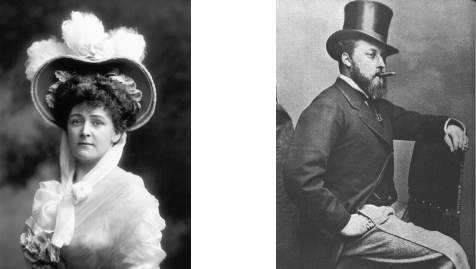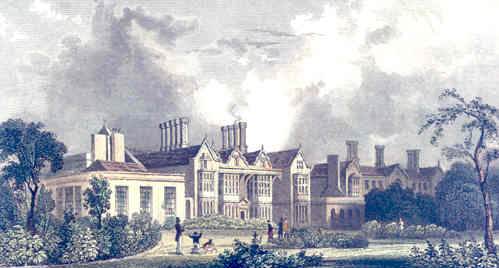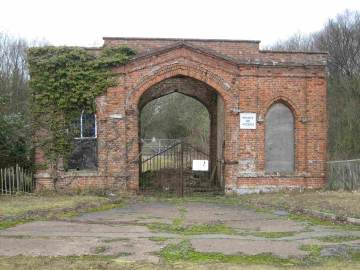Lady Warwick’s station
The line was opened by the Great Eastern Railway on 22 February 1869. In 1895, a new station — later demoted to a ‘halt’, or request stop — was added here to serve Easton Lodge. Situated a mile or so to the north, the Lodge was one of the homes of the Earl and Countess of Warwick, who paid for the station's construction. The station was available for public use, and only closed when the line ceased to carry passengers on 3 May 1952.
Though the wooden waiting room has gone, the crossing-keeper’s house and his signal- and gate-lever hut remain. These are now a private dwelling, so please do not trespass onto the property.

Easton Lodge Halt, c1900 The gatekeeper's house
(photo B D G Walsh) and lever hut, 2010
The platform was constructed of earth on clinker, with a timber facing, the remains of which can still be seen in the garden, as a bank on the northern side of the old trackbed.
'Darling Daisy'
Frances Evelyn ‘Daisy’ Greville (née Maynard), Countess of Warwick (1861–1938) is perhaps best known to history as the ‘Darling Daisy wife’, the dazzling and wealthy society beauty who was from 1883 the paramour of Albert Edward, the Prince of Wales. Known to his family as ‘Bertie’, he was the second child, but eldest son, of Queen Victoria and was crowned her successor, King-Emperor Edward VII in 1901.

Daisy, Countess Bertie, Prince of
of Warwick Wales
Daisy and her accommodating husband paid for the construction of Easton Lodge station, and there is little doubt that it was built to provide a convenient and discreet route for the future King to visit his mistress, along with other members of the 'Marlborough House Set', an international crowd of aristocrats who clung to the Prince; their group photograph on the still-recognisable steps of the Lodge can be seen in a small exhibition at the Lodge.
Bertie was a regular visitor to Easton Lodge until 1898, when Daisy’s much earlier indiscreet correspondence with another lover, Lord Beresford, were exposed by Beresford's wife. Daisy was replaced in the Prince’s affections by Alice Keppel (the Hon. Mrs George Keppel, great-grandmother of the present Camilla, Duchess of Cornwall), who remained his devoted mistress until his death in 1910.
The Countess continued to live on the Easton estate until her death. She was the author of 12 published books, and became a ferociously active socialist, standing as Labour candidate for the Warwick and Leamington Parliamentary constituency in the 1923 General Election (and losing, to Anthony Eden). She was also the magnet — mainly financial — which attracted an astonishingly diverse circle of 20th Century British left-wing artists, entertainers, writers and politicians to visit or live in the neighbouring villages (a few were Gustav Holst, H G Wells, Ramsay MacDonald, Ellen Terry, A A Milne, Manny Shinwell, George Bernard Shaw, H de Vere Stacpoole and Charlie Chaplin — I list them with pride and honour). She died in 1938 at the age of 78, virtually bankrupt.
Bombs and Bananas
Following Lady Warwick’s death, the Lodge was requisitioned by the Government during the Second World War. More than 10,000 trees in Easton Park were dynamited in order to create RAF Great Dunmow airfield ‘Station 164’, one of dozens of fighter and bomber stations in the area. (Another of these has since become rather more famous — ‘Station 169’ was RAF Stansted Mountfitchet). The concrete runways and the foundations of the control tower can still be seen in Easton Park.
Between September 1943 and October 1944, Easton Lodge and its airfield were assigned to 386th Bombardment Group (Medium) — aka ‘The Crusaders’ — of the 8th, and later 9th, Air Force USAAF; there is a memorial to 173 of their dead at N51°52.1076’ E0°18.9622’, and an impressive commemorative chapel and stained glass window in Little Easton church, near to the Lodge. For much more information about the airfield, see the description of cache GC26NDQ.
The modern Winfresh banana ripening centre on the south side of Easton Lodge Halt is built on the site of the wartime munitions depot, long demolished, which supplied the nearby airfields. The railway became a vital supply route, delivering thousands of tons of the airborne weapons which would help to win the War in Europe. It was defended by many 'pillbox' gun emplacements, of which several can still be seen along the Flitch Way.
The Flitch Way Country Park picnic area and car park are situated on the former railway siding, now overgrown, which led to the munitions depot.
Easton Lodge
The Lodge was the grand residence of the influential Maynard family from the mid 16th century. The original medieval house was extensively rebuilt after several disastrous fires and was finally demolished following a further fire in 1950, with the exception of the west wing (‘Warwick House’) which is still occupied. The site of the demolished house was planted with a grove of birch trees.

Easton Lodge c1834
In 1902 Harold Peto was commissioned by the Countess to design elaborate new gardens, which alas decayed and disappeared with the house. However the recent owners have ambitiously restored the Peto gardens, and they are now opened to the public each spring and summer with the help of a number of volunteer staff. The restored gardens have until recently been threatened by the proposed expansion of Stansted Airport — now cancelled. The takeoff point for the projected second runway would have been just 640 metres from the garden boundary!

Peto's 1902 'Italian' garden ... and today (winter 2010)
The main entrance gatehouse to Easton Park was at High Wood, a short carriage-ride from the Halt. Now dangerously derelict, the gate can still be seen from the Flitch Way: from the bridge at GCVAMW, look NW to the roundabout at the A120/B1256 junction.

High Wood Gatehouse
I learned much of this history in the early 1980s from the late and estimable Mrs Felice ‘Bunty’ Spurrier. She was the daughter of Maynard Greville, who was the fourth son of Daisy, Countess of Warwick. He was — significantly — born in 1898 (d 1960). Felice was the last Maynard descendant to live at Easton Lodge.
In old age Mrs Spurrier bore an astonishing likeness to Queen Victoria. The dates suggest that she may well have been Victoria's great-granddaughter, though other sources dispute this, asserting that her grandfather was actually one Joe Laycock, a millionaire bachelor who served as an Army officer in the Boer War ….